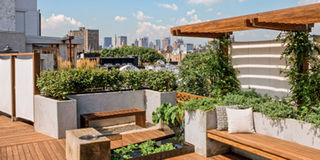Setting up a rooftop garden

A rooftop garden is a good option for people who do not have enough compound space to grow either vegetables or flowers. NET PHOTO
What you need to know:
- If you have limited space for gardening but have a slab for a roof, you plant a garden on it. All you need is the right soil and plants.
With the cost of land ever increasing, people have decided to buy small plots of land. But in such a case, they at times end up with no space to grow some plants.
However, if you are living in such space, you now have an option. With prior planning, you can opt for a roof garden which is the type of garden planted on a roof of a building.
The appropriate roof type
Bruno Serunkuuma a landscape gardener at Community Integrated Development Initiatives says concrete slabs are much better for this kind of gardening since they are strong enough to carry the gardens’ weight.
“You can set up the planters within the roof itself or use plastic planters for this kind of gardening,” he says.
Plant choice
Serunkuuma notes that fiber-rooted plants are a better option for a roof garden than tap-rooted plants. “This is because tap-rooted plants can grow into the building and harm the structure.”
He adds, “Since there is a lot of wind at the rooftop, plants with a few leafs are ideal for such a garden and they will be able to tolerate direct sunlight,” he says.
Your plant choice should not exceed four metres tall because they will not be stable in the container with the wind swinging them in several directions.
Serunkuuma says the ideal kind of plants for roof top gardening can be plants such as spider grass, cactus, ferns and society garlic among others.
“You can also embrace water gardens on the roof to enhance variety, for instance plants such as water hyphen, Nile cabbage, and umbrella papyrus.
Ideal soil
For the soil, Serunkuuma says you should get the type that will not exert pressure on the building. “The best type of soil for rooftop gardening is sandy loam soil since it has a medium texture which avoids compaction and this allows the plant roots to move in the soil with ease.”
“This kind of soil is a mixture of normal soil, lake sand and compost manure in ratios of 4:1:2 respectively,” he adds.
Maintenance
• Before starting, it is important to till, weed, and eliminate any pests for proper yields.
• Ensure that you look out for low cost maintenance plants that will be able to endure the rough atmosphere at the roof. This will help you have a firm garden.
• Watering should be a habit. Whenever you put your finger in the soil and you find it dry, irrigate the plants. It is recommended to do irrigation late in the evening at around 6pm.
• Weed and prune the garden regularly to ensure that the plants look good. It also adds beauty to your garden in case you are the kind that likes people to visit it.
• Add fertilizers and a little manure at least once every month to keep the plants healthy. Spraying once in a while is also ideal for better produce.
• Change the soil container every after two years as it will help the plants to grow in good shapes.
The importance
Aside from the decorative benefits, these roof plantings actually provide temperature control, food, and habitats for wildlife, along with recreational opportunities and architectural enhancement. They also promote a healthier environment.




